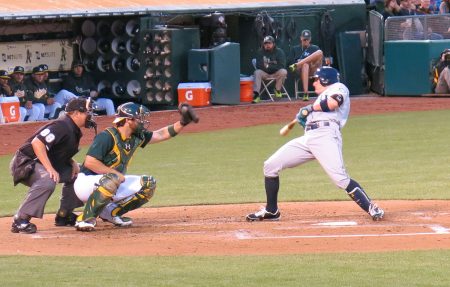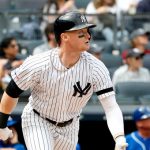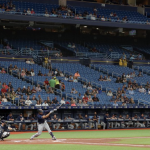Chin Music is Back Thanks to Men in Black
 There they are. See them? Behind each base. Those men in black are not Tommy Lee Jones or Will Smith, they’re MLB umpires. And they’re witnesses to the rebirth of chin music.
There they are. See them? Behind each base. Those men in black are not Tommy Lee Jones or Will Smith, they’re MLB umpires. And they’re witnesses to the rebirth of chin music.
The home plate umpire is the one who wears a mask and crouches behind the catcher. His chest protector is worn inside his jacket, or shirt if there’s no jacket, and he, more than any of the other umpires, determines the tenor of the game.
Because the home plate umpire controls the 4.5 cubic feet at the center of the game. The strike zone that extends over a pentagon (home plate) like a conceptual hologram fluttering beside the batter and in front of the catcher and umpire. That’s heart of the baseball world where chin music has been reprised.
The 2019 Official Baseball Rules establish the zone’s upper limit at a horizontal line at the midpoint between the top of the shoulders and the top of the uniform pants, and the lower level is a line at the hollow beneath the kneecap.
That is the strike zone today. It is the same width, 17 inches, as home plate. But the strike zone also includes the width of a baseball, or about 2.5 inches, on either side. Meaning that if any part of the ball abrades any part of this 22 inch width, the home plate umpire should call the pitch a strike.
The pitch should be called a strike if it touches any of the 22 inches. But the adventure starts here. No one knows for sure what the umpire will call. Or whether he’ll call it a strike once, or several times, or consistently call the pitch a strike every time the pitch is thrown.
In an essay written by a Boston University business school lecturer this past April 2019, Mark T. Williams alleges that, during the 2018 season, MLB umpires missed 34,294 ball/strike calls or 14 per game. The authors evaluated 11 years of baseball data and found, in general, younger umpires make fewer errors than older umpires and, as has been the case in so many other instances, MLB continues to drag its feet regarding fundamental changes to the management of the game and the strike zone.
In short, this study offers proof that all the participants in the ball/strike calling process (players and managers) have reason to be confused if not downright angry occasionally when what should be called is either missed or erroneously called.
The Strike Zone
Ted Williams once commented about the strike zone, that . . . a batter has three strike zones: his own, the opposing pitcher’s, and the umpire’s. The umpire’s zone is defined by the rule book, but it’s also more importantly defined by the way the umpire works [author’s emphasis]. A good umpire is consistent so you can learn his strike zone. The batter has a strike zone in which he considers the pitch the right one to hit. The pitchers have zones where they are most effective.
The way an umpire works. Sometimes, they’re barely noticeable, and the game proceeds so smoothly. Other times, they’re at the center of a maelstrom when there’s a controversial call, or teams brawl, or nearly every ball or strike call is challenged by someone because the umpire has been inconsistent all game.
So, every game is different because, even with video cameras evaluating an umpire’s ball and strike calls, there is no uniform strike zone despite its definition in the rule book. Besides, the strike zone has been revised at different moments in time to reflect changing trends in the game.
A Strike Zone Revision, 1960s Style
In 1961, when Roger Maris broke Babe Ruth’s single-season home run record when he homered off Tracy Stallard of the Boston Red Sox in the last game of the season for his 61st home run, many in baseball refused to recognize the legitimacy of the new record.
Why?
Babe Ruth had hit his 60 homers in the old 154 game schedule, while Maris needed all 162 games to break Ruth’s sacred 34-year-old record.
Commissioner Ford Frick was one of those who thought Maris’ achievement cheapened home runs and insisted on the now famous asterisk next to Maris’ 61 home runs. Which was baseball’s way of saying it happened, but it happened in eight extra games. So … asterisk.
Frick worried that if Maris could hit 61 home runs, anybody could. This cheapened the product in his eyes. How ironic given the frequency of home runs in 2019.
To protect pitching, Frick had the strike zone enlarged in 1963 to cover the area from the top of the shoulder to the bottom of the knee.
What MLB hoped would happen, did happen. Games were played quicker, and fewer home runs were hit. But what MLB did not anticipate was that bases on balls would decrease as the dreaded strikeout increased. Alongside these trends, batting averages declined.
Carl Yastrzemski led the American League with a .301 batting average in 1968 (the only hitter above .300 in the American League) while Pete Rose led the National League at .335. (only four others topped .300 in the National League).
No wonder 1968 was known as the year of the pitcher. Bob Gibson had the greatest year of all pitchers in 1968. He threw more than 300 innings, pitched to a sizzling 1.12 ERA, and completed 28 of his 34 starts. Pretty darn good.
As for the home run leaders in 1968 there was only one 40 home run hitter, six 30+ home run hitters, and 16 20+ home run hitters. And that was in the American and National Leagues. While in 2018 there were three 40+ home run hitters, 24 30+ home run hitters, and 62 20+ home run hitters in the major leagues. That’s a lot of home run hitting.
The very next year, 1969, the new Commissioner, Bowie Kuhn, made changes. The pitching mound was lowered from 15 inches above home plate to ten inches. And the strike zone was returned to its 1961 dimensions, the year Roger Maris hit his 61 homers. Great pitching was wonderful, but MLB feared the game would suffer without a lot of offense. Only a few years later, in 1973, the American League adopted the Designated Hitter. And hitters were off to the races.
So, Where are We?
Back to the high strike again after years of oblivion. Reprising chin music.
The MLB umpires were rearranged in 2000 into one group who umpire all games. American League, National League, inter-league—it no longer matters. All umpires now wear the inside chest protector so they should be able to call the low strike with ease.
But, pitching has changed, and one of the ways to keep the ball in the ballpark is to throw it at the top of the strike zone. Or well below the knees. Which is why split-finger fastballs and sinkers are so effective when they’re bounced in the dirt. And why so much high-90s gas is now tossed up around the hitter’s head.
Nothing like reprising chin music.
So, there is no longer a low-ball and high-ball league. There’s one strike zone, supposedly, one interpretation of the strike zone, or so MLB prefers to allege.
Truth is, there were 89 umpires (in 2018) who called balls and strikes. Saying that there were 89 umpires last season means that there were 89 different strike zones.
Now factor in every game that a team sends out a different starting pitcher. So, immediately it’s a different game than the one before. And with different starting pitchers and a different home plate umpire every game, as umpires rotate through their sequence from third base to home plate, the dynamics of every game are different.
Only the sweet sound of chin music is still the same. From Amos Rusie to Walter Johnson, Dizzy Dean, Bob Feller, Nolan Ryan, Roger Clemens, Randy Johnson and all the other pitchers clipping 100+ with their fastballs in todays’ game, that whizz of air as the ball hurtles past the batter’s chin is a reminder that, in some ways, baseball is still the same game it always has been. Up and in, down and away (we go).

























